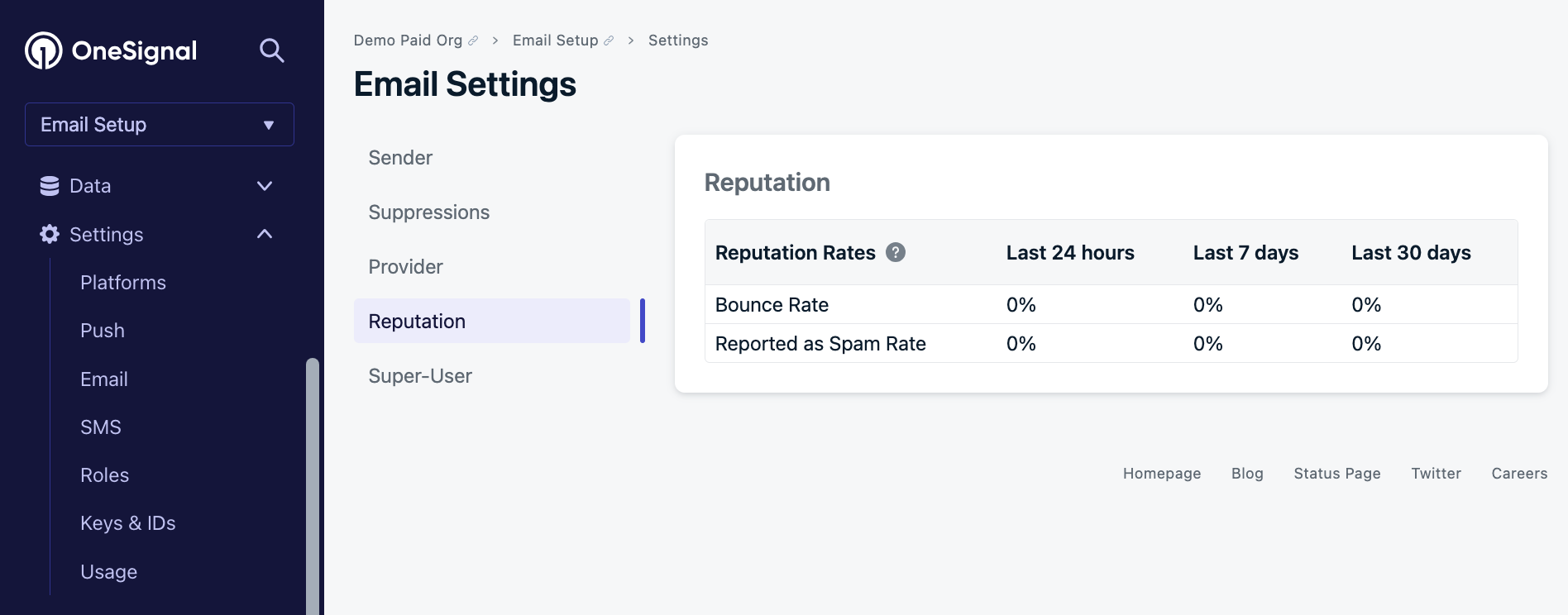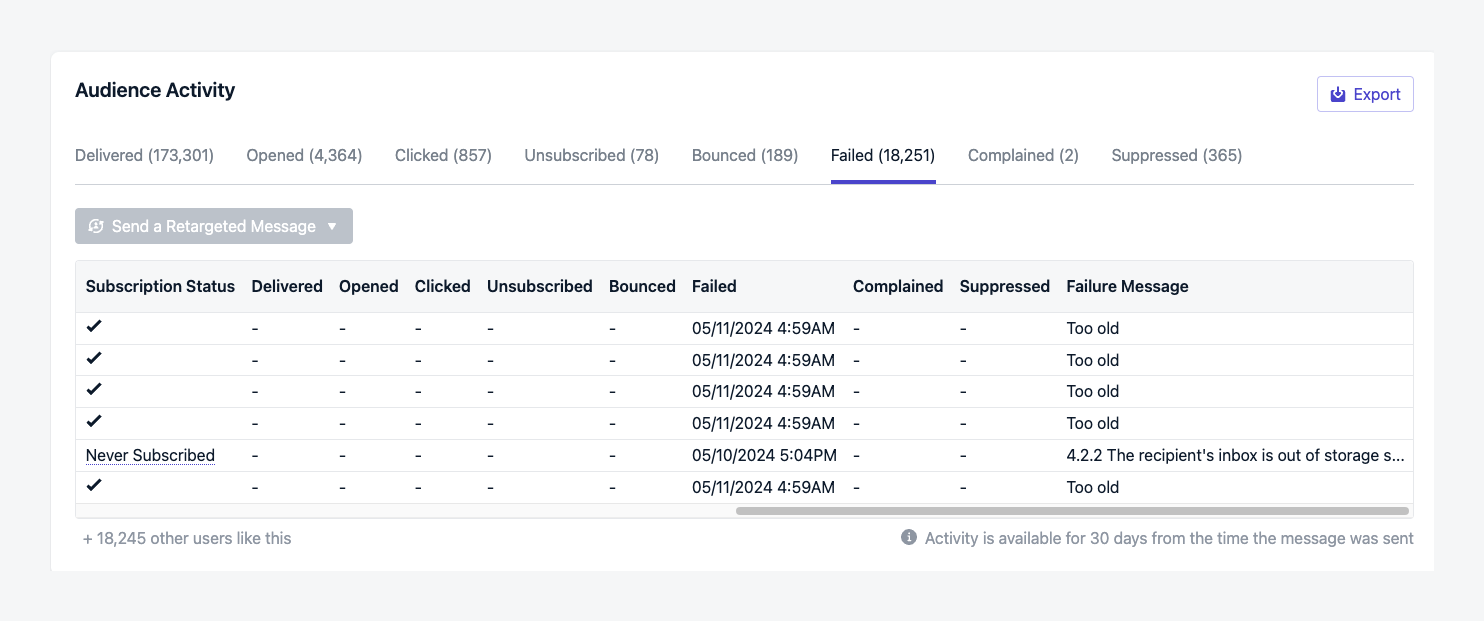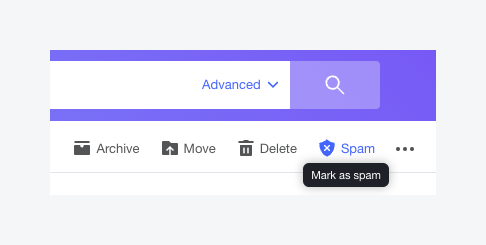Email deliverability
Reputation and Landing in the Inbox.
Email deliverability is the ability of an email to reach your recipient’s inbox rather than being blocked, sent to spam, or lost in transit. It depends on various factors, including sender reputation, email content, and recipient engagement. Ensuring good deliverability involves understanding the practices and criteria used by internet service providers (ISPs) and mailbox providers, who assess every incoming email to filter out unwanted or harmful messages.
Reputation
Email Sending Reputation is assigned to you by Inbox Service Providers and is at the core of email deliverability. Your reputation will determine Inbox placement, the amount of mail Inbox Service Providers will accept from you, and if your emails will be outright blocked by Inbox Service Providers.
Your Sending Reputation works like a credit score that can go up or down based on the historical performance of your mail. Your reputation may be positively affected if you have a high engagement with your emails like opens, clicks or replies. Your reputation may be negatively affected if you receive Spam Complaints from recipients, you have a high bounce rate, or if you send to spam traps.
If your bounce and spam report rates are too high, it will affect your domain and IP reputation which reduces deliverability and potentially violates our Acceptable Use Policy & Code of Conduct. You should aim for as little bounces and complaints as possible. A bounce rate greater than 5% and a complaint rate higher than 0.08% is considered high and would hurt the reputation of a domain, likely to be flagged by the Inbox service provider. See Google's Sender Guidelines for more details.
If you are using OneSignal email, you can view the rate at which these events occurred within Settings > Email > Reputation. If you are using a 3rd party integration like SendGrid, Mailchimp, or Mailgun you can find this data in those tool's dashboards.
The rates in which your users bounce or report your emails as spam over a 24-hour, 7-day, and 30-day period. Rates are calculated across all emails sent in the current app.

Email Reputation Dashboard
Gmail spam rate
Due to Gmail restrictions, the "Reported as Spam Rate" does NOT account for complaints from Gmail recipients. In order to see your reported "Spam Rate" with Gmail, you must connect Google Postmaster Tools.
Steps to maintain good reputation
Common guidelines to follow before sending emails.
Remove unengaged recipients
Recommended for complaints and bounces
Consider implementing a sunset policy for recipients that do not engage with your emails after a set amount of time. Unengaged recipients are more likely to complain on subsequent emails and are more likely to become invalid. Try excluding recipients who have not engaged with 4 emails in a row or have not engaged with emails in 3 months, whichever comes first. This can always be adjusted later.
In Journeys, this can be done with Yes/No Branches by only allowing recipients to continue through a Journey if they have opened or clicked a prior email. You can also Tag unengaged users in Journeys so that they can be excluded in your other Segments.
Remove invalid email addresses
Recommended for bounces
Before you start Importing email addresses to your OneSignal app, you should remove any email addresses from your list that are invalid, inactive, or obtained without specific consent to receive emails.
For example, email addresses that are misspelled, wrong, or contain invalid characters should be removed, ie @gnail.com, @yagoo.com, emails with multiple or missing @ signs, no email domain names ([email protected]), missing top-level domains (something@example), etc.
If you already sent emails from another email platform, then that platform likely has a Suppression List. It is recommended to either not import these emails to your OneSignal app, delete them from your OneSignal app, or use a CSV to import them while setting the subscribed status to no.
Email validation tools
List validation and verification tools can be helpful to try removing bad addresses but do not reduce complaints and do not catch all invalid email addresses. It is strongly recommended that these tools are used alongside best practices.
Once you have a validated list, you can import emails following the Import Email Addresses guide.
Consent and opt-ins
You should only send emails to recipients who have knowingly signed up to receive emails. When a person uses a valid email to sign in to the app, they don't necessarily acknowledge that they want to receive emails. Make sure to ask the user to acknowledge that they will be receiving marketing or promotional emails.
Implement a confirmed or double opt-in approach
Recommended for complaints and bounces
Double opt-in (DOI) is important for sending marketing emails to your users because it ensures higher-quality engagement, improves deliverability, and helps you stay compliant with regulations. Here’s why it matters:
- Reduces Spam Complaints & Invalid Emails – Since users have to confirm their subscription, you avoid collecting fake or mistyped email addresses, reducing bounces and spam complaints.
- Improves Email Deliverability – ISPs (like Gmail, Yahoo, etc.) track how recipients engage with your emails. Since DOI leads to more engaged subscribers, your emails are less likely to be marked as spam.
- Ensures Compliance – Regulations like GDPR, CAN-SPAM, and CASL require clear consent before sending marketing emails. DOI provides a verifiable confirmation that the user willingly opted in.
- Higher Engagement & Conversion Rates – Users who confirm their interest are more likely to open, click, and engage with your emails, leading to better campaign performance.
- Prevents Abuse & List Bombing – Without DOI, someone could enter another person’s email without their consent, leading to complaints and blacklisting of your sending domain.
Confirmed Opt-in
Learn more about Setting Up a Double Opt-In with OneSignal
Warm up
Reputation also dictates the volume that Inbox Providers are willing to accept from you. If you attempt to send a high volume from a subdomain that has never sent or has not sent high volumes recently, then it is likely to get rejected and treated poorly.
When starting to send email on a new platform, from a new subdomain or suddenly increasing your volumes from the first time in a while, you will likely need to go through a "Warm Up" process to ensure the best email deliverability.
Warming up your domain
Check out our Auto Warm Up Feature.
Important concepts
Common terms used for email messaging.
Unsubscribed
Unsubscribes occur when recipients choose to opt-out of receiving further email communications from a sender. This action is typically initiated by clicking on an "unsubscribe" link included in the email message. Unsubscribes are a fundamental aspect of email marketing compliance and recipient consent.
When a recipient unsubscribes, it indicates a lack of interest or preference to disengage from future email interactions. As such, honoring unsubscribe requests promptly is essential for maintaining sender reputation, compliance with anti-spam regulations like the CAN-SPAM Act, and fostering positive recipient relationships.
These events are available in Event Streams.
Unsubscribe links
Learn more about Unsubscribe Links & Email Subscriptions. You can also Create a custom unsubscribe page.
Bounced
A bounce occurs when an email can not be delivered to a target email address. They generally occur because you are sending to email addresses that do not exist or are spelled incorrectly.
Bounced email addresses, the date the bounce was detected, and the reason for the bounce can be found in your Suppression List.
These events are available in Event Streams.
Failed
Failures may occur if your domain is misaligned, recipient inboxes are full, or if you are being blocked by Inbox Providers for having a poor reputation.

"Too Old" deferral messages from Gmail for Poor Reputation
Failures may be temporary and are often retired by our servers for a duration.
Failures can be seen in your Audience Activity on your Email Message Reports and do not get added to your Suppression List.
These events are available in Event Streams.
Spam complained
Complaints or "Spam Reports" arise when a recipient reports or marks an email as spam in their inbox.

Yahoo Report Spam Button
Common reasons for complaints include irrelevant content, excessive frequency, or emailing recipients that did not opt-in.
To maintain a positive sending reputation and avoid deliverability issues, it is important to minimize complaint rates. Regularly analyze feedback, adjust content strategies, and provide easy opt-out options to ensure a satisfactory email experience for recipients. Follow the above best practices to keep your complaints low.
These events are available in Event Streams.
Gmail spam complaints
Due to Gmail restrictions, Gmail users that mark your emails as spam can only be reported in Google Postmaster Tools.
Suppression list
The suppression list prevents you from sending to email addresses that have bounced as invalid and to recipients who have reported your mail as spam. Email addresses are automatically added to this list when they are detected as either bounced or spam. You can manage your suppressions in email settings. See our guide on managing suppressions.
Blocklists
Blocklists are lists of IP addresses or domains that have been identified as sources of spam or malicious activity. Inbox Providers have internal blocklists and often consult 3d party blocklists to filter out unwanted emails. If your IP address or domain is on a blocklist, your emails may be automatically rejected or sent to the spam folder.
Spam traps
Spam traps are email addresses that are not actively used by real individuals but are set up by ISPs or anti-spam organizations to identify spammers. If you send emails to spam traps, it indicates poor list hygiene or acquisition practices and can severely damage your sending reputation.
Learn more about spam traps (click to expand)
Spam Traps are email addresses that are not owned or operated by actual recipients. They are operated by Inbox Providers and 3rd party operators that report to, or are referenced by Inbox Providers.
Sending to Spam Traps can land your domain or IPs on a blocklist. Being on a blocklist means that some inboxes will reject your emails.
Spam Traps are designed to highlight recipient hygiene and acquisition issues.
Some common spam trap networks are SpamHaus, Abusix and Microsoft's SNDS.
There are multiple types of spam traps that can be prevented by following email best practices.
Pristine
Email addresses set up for the sole purpose of being monitored as spam traps. Found on public websites and purchased lists.
Recycled
Email addresses that used to belong to an actual recipient, but have been repurposed to be a spam trap. Often abandoned inboxes or domains.
Typo
Email addresses set up with common typos, such as "gnail.com", "tahoo.com", "gmail.con", "outlooj.com", etc.
How to Avoid Spam Traps
Note: List cleaning tools will not remove spam traps.
Prevent Spam Traps
Implement a "Confirmed" or "Double" Opt-in. When a new contact gives you their email address via a form on your website or elsewhere, you send them an immediate email that requires them to confirm:
A. That the email address is valid.
B. That the email address is actually operated by the recipient.
Learn how to implement a double opt-in using OneSignal's Magic Link
Remove Spam Traps
Remove unengaged email recipient addresses. Spam Traps don't bounce back as invalid, but don't engage with your mail either. If a recipient has received multiple emails without clicking or even opening the email, then it would be a good idea to remove them from your lists.
Try sending your next emails with Journeys so that you can tag unengaged recipients based on [Previous Message Behavior](https://documentation.onesignal.com/docs/journeys#previous-message-behavior)
Similarly to a Confirmed opt-in email, consider sending older recipients a pulse check email that they are required to interact with or they get removed from your sending lists. Then use a Retargeting Message on the engaged recipients.
Opened
Opens refer to the number of times recipients open your email messages. Tracking email opens provides insights into the effectiveness of your subject lines, targeting and sender identity. High open rates indicate good inbox placement and engagement from recipients.
Clicked
Clicks represent the number of times recipients interact with links within your email messages. Tracking clicks allows you to measure the engagement and effectiveness of your email content and call-to-action (CTA). High click-through rates indicate that your emails are resonating with recipients and driving desired actions. Since recipients must open emails before being able to click a link, clicks are a very strong indicator of engagement.
Inbox placement
Inbox placement refers to where your email messages are delivered within recipients' email inboxes. Proper inbox placement ensures that your emails are seen by recipients in the correct context and increases the likelihood of engagement. Inbox placement can be categorized into different sections of the inbox, such as Primary, Promotions, or Spam folders.

Gmail Inbox Tabs
Primary
The Primary Tab typically where important and personal communications are received. Achieving primary inbox placement indicates good sender reputation and email relevance, increasing the likelihood of recipients engaging with your messages.
Promotions
Promotions refers to emails that are delivered to a separate tab or folder within recipients' inboxes, specifically designated for promotional or marketing emails. While still visible to recipients, emails in the Promotions tab may receive less immediate attention compared to those in the Primary inbox. Inbox Providers often use algorithms to determine which emails are categorized as promotions based on sender reputation and email content.
Emails Landing In Promotions (click to expand)
Emails landing in the Promotions Tab is not an indicator of bad reputation and is not a bad place for marketing emails to land. If an email is inherently promotional or marketing related, then it may actually perform better in the context of the promotions tab.
The promotions tab has been found to reduce spam complaints and increase engagement as it helps emails meet the expectations of recipients. When a recipient visits their promotions tab, they are in a different mindset and are more receptive to looking for deals or shopping.
Emails often land in promotions due to automated filters categorizing them based on content and previous recipient behavior. To land more in the primary tab, avoid using excessive promotional language, personalize content, and encourage recipients to move emails to their primary tab.
Spam
Spam inbox placement refers to emails that are filtered by Inbox Providers and delivered to recipients' spam or junk folders. Emails categorized as spam may contain suspicious or unwanted content, trigger spam filters, or have low sender reputation.
Emails Landing In Spam (click to expand)
Emails landing in the Spam Folder is usually an indicator that you currently have a poor reputation. The first thing you should check is for anything that would have negatively affected your reputation. Has your complaint or bounce rate been higher than it should be? According to Google, "senders should keep their spam rate below 0.1%".
Follow the above Reputation best practices to lower bounce and complaint rates. If placement in the spam folder does not seem reputation related, double check that your DMARC is properly aligned. About My Email is a great testing tool to check for alignment.
Updated 3 months ago
